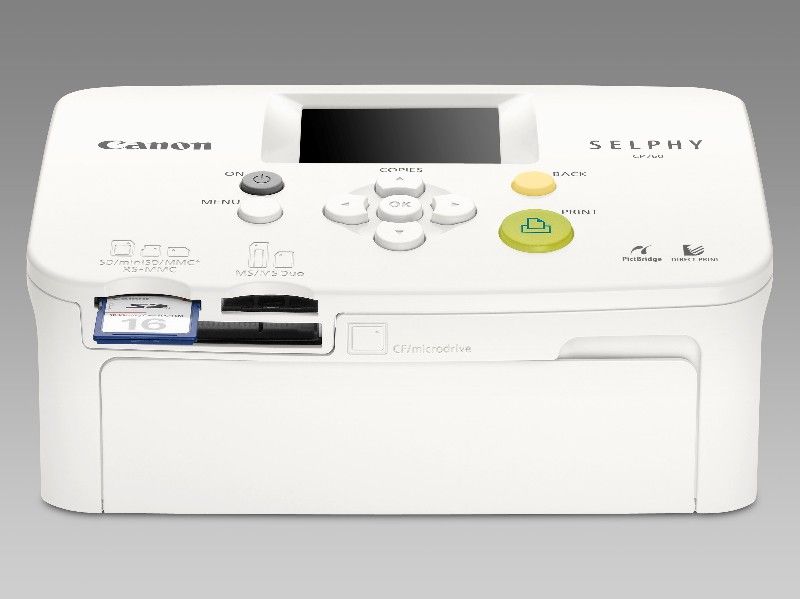Like many in the digital imaging age, you find yourself without "real" photos. You could order online, take you memory card to a high street store for prints, or do it yourself at home. Canon think they have just the tool for the job, so we get printing with the Selphy 760 to find out what it’s all about.
The compact printer is fairly conservative in design, sporting the off-white colouring of computers of yesteryear. That said, this is a photo printer, and function is the most important thing. Unlike the Selphy CP770, this printer is happier in a static location, although does pack-up easily enough for portability after removing the paper tray.
The printer comes supplied with the paper tray to support standard 6 x 4in images; you get an ink and paper pack that will give you a miserly five pictures, which seems to be a bit of a con. Additional trays and accessories are available to purchase from Canon, including a Bluetooth dongle for wireless printing, should you be so inclined.
The printer supports PictBridge and Canon Direct Print for printing from supported cameras, PC printing via a standard printer cable, or through the memory card reader that supports SD/miniSD, MMC, RS-MMC, MS, MS Duo, and Compact Flash, although adapters could enable a range of other cards. Unfortunately you can’t print directs from a USB thumb drive.
In terms of printing quality, we were very impressed with the results. To get the best results, printing from a PC will allow you the full range of options of your photo-editing software before you print the picture, however, most users will probably want this type of printer so they can skip the PC part.
The LCD display allows you to view images and access the menu to select the options you want. The screen itself is not such good quality, and at 2.5in, has to share the image preview with other information which eats away at the edges, although you can minimise this. In reality, you can recognise what the picture is, but can’t see much detail, so if you want to choose which is the better of two shots, then this is not the place to do it.
The CP760 will allow you to turn on a red-eye correction option, which works perfectly well, although your camera might have already done this for you and it doesn't pick up rogue red-eyes in the background. There are also a number of "My Color" options, so you can pick specifics, like natural or vivid, and the more common options such as sepia. In reality, it’s a question of personal taste and worth experimenting on an image in advance to see what works. You can also select bordered prints, and in-built image optimisation, although, if you have a poor photo to begin with, you’ll still get a poor print.
The system overlays each colour individually in a dye-sublimation thermal transfer system (at 300dpi), so you need to make sure there is space around the back of your printer as your paper will pop out as it makes it’s pass to pick up a colour. It is also important not to touch the front of the paper, as the oil transfer from your fingers will inhibit the ink bonding with the paper. We found that an average 6 x 4in print took 1min 15sec, slightly longer than the quoted 52sec on the spec sheet, from pressing the print button to collecting the photo.
We did find a small degree of colour bleed, especially where you have bright colours on a white background – baby toys and logos on clothing. Overall, images are slightly on the dark side, so if you have picture where your subject is in shadow, a lot of detail will be lost. The image optimiser does lighten images slightly, but there is still a noticeable different between images viewed on your camera or PC, and the resultant image from the printer.
Once you know however, you can pick your images, and general daily snaps work very well: flesh tones are well represented and colours are generally good.
The controls are well laid out and incredibly simple, although not being able to apply settings directly to individual photos, rather entire printing jobs, can be a little tedious, although in reality, you’ll probably turn on the image optimiser and the red-eye correction, and thereafter rarely want to change the settings.
Our quick take
We think the LCD screen could have been better quality, and given the space available on the top, could be a bigger size.
The colour bleed was a disappointment, but otherwise the photo quality from this portable printer is very good. Depending on how much you pay for the ink and paper, photos cost around 15 pence a pop, which is more than ordering online, but you do get instant results.
This is a compact unit that lacks the storage and battery options of the CP770, so is less suited for printing on the move, but comes in as better value for money.

Canon Selphy CP760 compact photo printer - 3.5 / 5
| FOR | AGAINST |
|---|---|
|
|
To recap
Some quality issues, but otherwise this is a competent little photo printer that is simple to use with plenty of connection options
